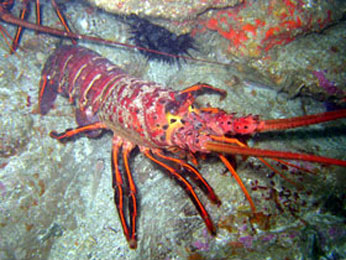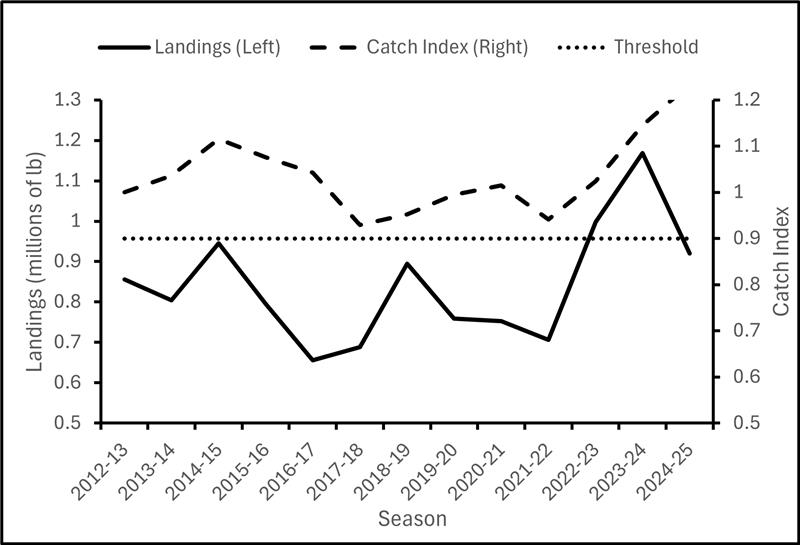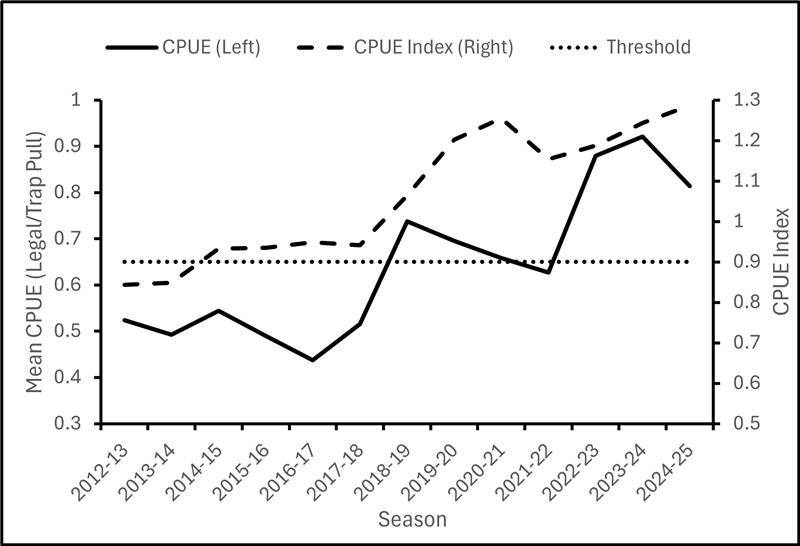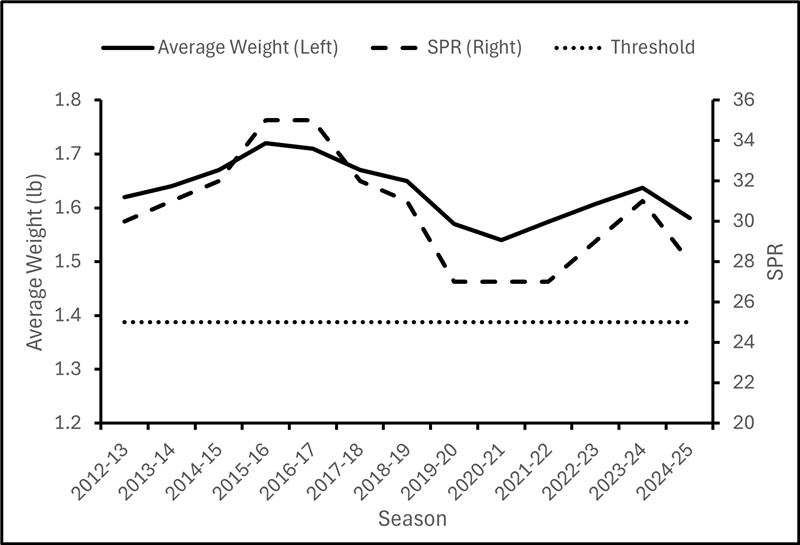Introduction
 California spiny lobster ventures from its den. CDFW photo by Derek Stein.
California spiny lobster ventures from its den. CDFW photo by Derek Stein.
The California spiny lobster is an important natural resource managed by the state of California for over 100 years. The species supports a valuable commercial fishery and a significant recreational fishery, and acts as an important keystone predator within the southern California nearshore ecosystem. Beginning in the spring of 2012, the California Department of Fish and Wildlife (CDFW) conducted a comprehensive review of the California spiny lobster fishery to develop a management framework in the form of a Fishery Management Plan (FMP) under the Marine Life Management Act (MLMA). The goal of the FMP is to formalize a management strategy for spiny lobster that will be responsive to environmental and socioeconomic changes and establish the basis for informed decision-making to achieve a sustainable fishery considering the entire ecosystem.
Two introductory meetings were held on April 18 and 19, 2012. A Lobster Advisory Committee consisting of a diverse group of stakeholders was formed, and an extensive series of public stakeholder meetings followed. The result was a Draft California Spiny Lobster FMP that was released for public review on December 9, 2015, and revised in January 2016 and again in April 2016 based on extensive comments (PDF) received from the public. On April 13, 2016, the California Fish and Game Commission (FGC) adopted the final California Spiny Lobster FMP to guide future management of the fishery as required by the MLMA.
The California Spiny Lobster FMP applies a harvest control rule (HCR) to guide management of the fishery. The HCR is a plan that monitors the status of the fishery and prescribes adjustments in harvest regulations (e.g., fishing effort, allowable catch, minimum legal size) that are activated when a defined catch or biological limit, also known as a reference point threshold, is reached. CDFW sought an independent scientific assessment of whether the technical components and supporting documents that underpin the proposed reference points and their thresholds prescribed in the FMP are scientifically sound and reasonable given CDFW's currently available data streams and analysis techniques.
HCR Overview
As defined in the FMP, the California spiny lobster fishery is managed by a HCR with three components:
- Catch Index
The average seasonal commercial catch (in pounds) over the last three years is divided by the average seasonal commercial catch over the last ten years. If this ratio is above 0.9, no management evaluation is triggered.
- CPUE Index
The average seasonal commercial Catch per Unit Effort (CPUE, number of legal lobsters per trap pull) over the last three years is divided by the average seasonal commercial CPUE over the last ten years. If this ratio is above 0.9, no management evaluation is triggered.
- SPR
The Spawning Potential Ratio (SPR) is defined as the number of eggs produced by the current fished population divided by the number eggs produced by that same population if it were unfished. It is calculated each year using the average weight of commercially landed lobsters. If the value is above 25, no management evaluation is triggered.
For a detailed explanation of the HCR, see the Final California Spiny Lobster FMP (PDF) or Enhanced Status Report.
Status of the California Spiny Lobster Fishery
All three HCR indices remained above the threshold during the 2024-2025 season. No management action will be taken.
 Figure 1. Lobster Landings and Catch Index from 2012 to 2025.
Figure 1. Lobster Landings and Catch Index from 2012 to 2025.
 Figure 2. Lobster CPUE and CPUE Index from 2012 to 2025.
Figure 2. Lobster CPUE and CPUE Index from 2012 to 2025.
 Figure 3. Lobster Average Weight and SPR Index from 2012 to 2025.
Figure 3. Lobster Average Weight and SPR Index from 2012 to 2025.
Science Review of the California Spiny Lobster FMP
The MLMA identifies external scientific review as a key tool to ensure management decisions are based upon a foundation of the best available scientific information; therefore, CDFW asked the California Ocean Science Trust (OST) to coordinate an external scientific and technical review of the science supporting management of the spiny lobster resource. OST then formed an independent science review Committee in March 2015.
As part of the science review, CDFW provided a presentation and report to the Committee in March 2015 describing the structure, parameters, and the principal mathematical relationships in the Cable-CDFW model. The model is used to calculate spawning potential ratio (SPR), one of the three reference points prescribed by the HCR. In May 2015, OST completed the Final Report of the Scientific Review Committee (PDF). Changes made to the FMP in response to the committee recommendations are available in appendix VIII of the FMP. A report (PDF) describing the current Cable-CDFW model used to calculate SPR was produced by CDFW in January 2016.
California Spiny Lobster FMP Implementing Regulations
Upon the adoption of the FMP by the FGC, a corresponding set of implementing regulations was adopted to enact the FMP. The FGC first placed the public on notice of the Initial Statement of Reasons to establish the implementing regulations for the FMP on March 28, 2016. The FGC adopted the proposed regulations on June 22, 2016, and the California Office of Administrative Law approved the final version of the regulations on March 2, 2017. The regulations are in effect as of April 1, 2017.
Environmental Review Process
An Initial Study and Negative Declaration (ND) were prepared in order to meet environmental review requirements of the FMP and regulatory amendments, with the FGC as the lead agency. On January 21, 2016, the FGC published a Notice of Intent to adopt the Draft ND and began a 45-day public review and comment period that ended on March 7, 2016. The Final ND (PDF) was adopted by the FGC at its April 13, 2016 meeting.
California Spiny Lobster FMP Timeline
2012
- Public Meetings: April 18 and 19
- Lobster Advisory Committee Meetings:
June 20, August 1, December 5
2013
- Lobster Advisory Committee Meetings:
April 10, June 12, July 10, August 15, September 11
2014
- External Scientific Peer Review: November 2014 - February 2015
- Courtesy release of preliminary draft FMP: November 2014
2015
- CDFW submits the FMP. This starts the process for formal public review and comment of the FMP: December 9-10, 2015 FGC meeting.
2016
- 45-day public review of the draft Initial Study and ND: January 21-March 7, 2016.
- CDFW requests authorization to publish notice of intent to amend regulations. This starts the process for formal public review and comment of the proposed regulations: February 10 FGC meeting.
- Discussion and adoption of the FMP and certification of the ND: February 10 and April 13, 2016 FGC meetings.
- Discussion and adoption of the FMP implementing regulations: April 13 and June 22, 2016 FGC meetings.
2017
- FMP implementing regulations approved by the California Office of Administrative Law: March 2, 2017.
- FMP and adopted regulations effective for the 2017/18 lobster fishing season.